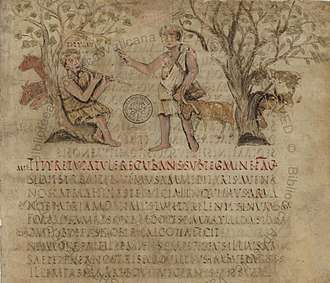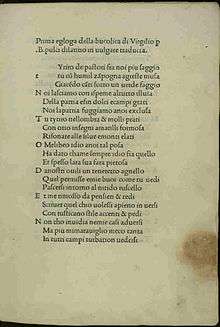Eclogues
The Eclogues (/ˈɛklɒɡz/; Latin: Eclogae [ˈɛklɔɡae̯]), also called the Bucolics, is the first of the three major works[1] of the Latin poet Virgil.

Background
Taking as his generic model the Greek bucolic poetry of Theocritus, Virgil created a Roman version partly by offering a dramatic and mythic interpretation of revolutionary change at Rome in the turbulent period between roughly 44 and 38 BC. Virgil introduced political clamor largely absent from Theocritus' poems, called idylls ("little scenes" or "vignettes"), even though erotic turbulence disturbs the "idyllic" landscapes of Theocritus.
Virgil's book contains ten pieces, each called not an idyll but an eclogue ("draft" or "selection" or "reckoning"), populated by and large with herdsmen imagined conversing and performing amoebaean singing in largely rural settings, whether suffering or embracing revolutionary change or happy or unhappy love. Performed with great success on the Roman stage, they feature a mix of visionary politics and eroticism that made Virgil a celebrity, legendary in his own lifetime.

Structure and organization
Like the rest of Virgil's works, the Eclogues are composed in dactylic hexameter.
It is likely that Virgil deliberately designed and arranged his book of Eclogues, in which case it is the first extant collection of Latin poems in the same meter put together by the poet. (Although it is thought that Catullus also compiled his book of poetry, it consists of poems written in different meters).[2][3]
Several scholars have attempted to identify the organizational/architectural principles underpinning the construction of the book. The book is arguably based on an alternation of antiphonal poems (e.g., dialogues) with non-dramatic/narrative poems.[4][5] Beyond this, there have been many attempts (with little consensus) to identify other organizational principles. Many of these attempts have been catalogued and critiqued by Niall Rudd.[6] Rudd refuted a number of cruder organizational theories, including theories that the Eclogues are organized
- in chronological order[7]
- by geographic setting, with Italian settings alternating with non-Italian settings[8]
- into two halves, each featuring a movement from lighter, more peaceful poems to heavier, more emphatic and agitated poems[9]
Rudd also identified more-convoluted organizational theories. While considering these more plausible than the above, he concluded that "each system has at least one defect, and none is so superior to the others as to be obviously Virgil's own".[10] Such systems include:
- arrangement based on mutually supporting principles, such as topical and arithmetic correspondences
- arrangement into a series of pairs of poems, bracketing Eclogue 5 with the balancing Eclogue 10 and supported by arithmetical correspondence (i.e., length of poems)
- arrangement into two halves, with corresponding pairs based on length
More recently, Thomas K. Hubbard has noted, "The first half of the book has often been seen as a positive construction of a pastoral vision, whilst the second half dramatizes progressive alienation from that vision, as each poem of the first half is taken up and responded to in reverse order."[11]
Eclogue 1
A dialogue between Tityrus and Meliboeus. In the turmoil of the era Meliboeus has been forced off his land and faces an uncertain future. Tityrus recounts his journey to Rome and the "god" he met there who answered his plea and allowed him to remain on his land. He offers to let Meliboeus spend the night with him.
Eclogue 2
A monologue by the shepherd Corydon bemoaning his unrequited love for Alexis in the height of summer.
Eclogue 3
A singing competition between Menalcas and Damoetas. Palaemon is the judge and pronounces the contest a tie.
Eclogue 4
Capping a sequence or cycle in which Virgil created and augmented a new political mythology, Eclogue 4 reaches out to imagine a golden age ushered in by the birth of a boy heralded as "great increase of Jove" (magnum Iovis incrementum), which ties in with divine associations claimed in the propaganda of Octavian, the ambitious young heir to Julius Caesar. The poet makes this notional scion of Jove the occasion to predict his own metabasis up the scale in epos, rising from the humble range of the bucolic to the lofty range of the heroic, potentially rivaling Homer: he thus signals his own ambition to make Roman epic that will culminate in the Aeneid. In the surge of ambition, Virgil also projects defeating the legendary poet Orpheus and his mother, the epic muse Calliope, as well as Pan, the inventor of the bucolic pipe, even in Pan's homeland of Arcadia, which Virgil will claim as his own at the climax of his eclogue book in the tenth eclogue. Biographical identification of the fourth eclogue's child has proved elusive; but the figure proved a link between traditional Roman authority and Christianity. The connection is first made in the Oration of Constantine[12] appended to the Life of Constantine by Eusebius of Caesarea (a reading to which Dante makes fleeting reference in his Purgatorio). Some scholars have also remarked similarities between the eclogue's prophetic themes and the words of Isaiah 11:6: "a little child shall lead".
Eclogue 5
Eclogue 5 articulates another significant pastoral theme, the shepherd-poet's concern with achieving worldly fame through poetry. This concern is related to the metabasis Virgil himself undertakes thematically in Eclogue 4. In Eclogue 5, the shepherds Menalcas and Mopsus mourn their deceased companion Daphnis by promising to "praise ... Daphnis to the stars – / yes, to the stars raise Daphnis". Menalcas and Mopsus praise Daphnis out of compassion but also out of obligation. Daphnis willed that his fellow shepherds memorialize him by making a "mound and add[ing] above the mound a song: / Daphnis am I in woodland, known hence far as the stars". Not only are Daphnis's survivors concerned with solidifying and eternizing his poetic reputation, but the dead shepherd-poet himself is involved in self-promotion from beyond the grave through the aegis of his will. It is an outgrowth of the friendly poetic rivalries that occur between them and of their attempts to best the gods, usually Pan or Phoebus, at their lyric craft. At the end of Eclogue 5, Daphnis is deified in the shepherds' poetic praise: "'A god, a god is he, Menalcas!' / ... Here are four altars: / Look, Daphnis, two for you and two high ones for Phoebus." Menalcas apostrophizes Daphnis with a promise: "Always your honor, name and praises will endure." Ensuring poetic fame is a fundamental interest of the shepherds in classical pastoral elegies, including the speaker in Milton's "Lycidas".[13]
Eclogue 8
This eclogue is also known as Pharmaceutria ("Sorceress").
Eclogue 10
In Eclogue 10, Virgil caps his book by inventing a new myth of poetic authority and origin: he replaces Theocritus' Sicily and old bucolic hero, the impassioned oxherd Daphnis, with the impassioned voice of his contemporary Roman friend, the elegiac poet Gaius Cornelius Gallus, imagined dying of love in Arcadia. Virgil transforms this remote, mountainous, and myth-ridden region of Greece, homeland of Pan, into the original and ideal place of pastoral song, thus founding a richly resonant tradition in western literature and the arts.
This eclogue is the origin of the phrase omnia vincit amor ("love conquers all").
See also
References
- Davis, Gregson (2010). "Introduction". Virgil's Eclogues, trans. Len Krisak. Philadelphia: U of Pennsylvania P. p. vii. ISBN 978-0-8122-4225-6
- Rudd, Niall (1976). Lines of Enquiry: Studies in Latin Poetry. Cambridge: Cambridge University Press. p. 119.
- Clausen, Wendell (1994). Virgil: Eclogues. Clarendon, Oxford University Press. p. xxi. ISBN 0-19-815035-0.
- Goold, G. P. (1999), Virgil: Eclogues, Georgics, Aeneid 1–6. Loeb Classical Library. Cambridge, MA: Harvard University Press. p. 2. ISBN 978-0-674-99583-3
- Rudd, Lines of Enquiry, pp. 121 ff.
- Rudd, Lines of Enquiry, pp. 119 ff.
- Rudd, Lines of Enquiry, pp. 125 ff., citing R. Helm in Bursians Jahresbericht (1902) and W. Port in Phililogus 81 (1926).
- Rudd, Lines of Enquiry, pp. 121 ff., citing R. S. Conway, Harvard Lectures on the Vergilian Age (1928), p. 139.
- Rudd, Lines of Enquiry, pp. 121 ff., citing Büchner.
- Rudd, Lines of Enquiry, pp. 141 ff.
- Hubbard, Thomas K. (1998). The Pipes of Pan: Intertextuality and Literary Filiation in the Pastoral Tradition from Theocritus to Milton. Ann Arbor: University of Michigan Press. p. 46. ISBN 978-0-472-10855-8
- Oration of Constantine
- Lee, Guy, trans. (1984). "Eclogue 5". In Virgil, The Eclogues. New York: Penguin. pp. 29–35.
Further reading
- Buckham, Philip Wentworth; Spence, Joseph; Holdsworth, Edward; Warburton, William; Jortin, John, Miscellanea Virgiliana: In Scriptis Maxime Eruditorum Virorum Varie Dispersa, in Unum Fasciculum Collecta, Cambridge : Printed for W. P. Grant; 1825.
- Coleman, Robert, ed. (1977). Vergil: Eclogues. Cambridge University Press. ISBN 0-521-29107-0.CS1 maint: multiple names: authors list (link) CS1 maint: extra text: authors list (link)
- Hornblower, Simon; Antony Spawforth (1999). The Oxford Classical Dictionary: Third Edition. Oxford University Press. ISBN 0-19-866172-X.
- Hunter, Richard, ed. (1999). Theocritus: A Selection. Cambridge University Press. ISBN 0-521-57420-X.CS1 maint: multiple names: authors list (link) CS1 maint: extra text: authors list (link)
- Van Sickle; John B. (2004). The Design of Virgil's Bucolics. Duckworth. ISBN 1-85399-676-9.
- _________. (2011). Virgil's Book of Bucolics, the Ten Eclogues in English Verse. Framed by Cues for Reading Out-Loud and Clues for Threading Texts and Themes. Johns Hopkins University Press. ISBN 0-8018-9799-8.CS1 maint: numeric names: authors list (link)|
External links
| Wikisource has original text related to this article: |
| Latin Wikisource has original text related to this article: |
| Wikiquote has quotations related to: Eclogues |
| Wikimedia Commons has media related to Eclogues. |
- The Eclogues (Internet Classics Archive)
- The Eclogues (Translated by H.R. Fairclough for the Loeb Classical Library, at Stoic Therapy)
- The Bucolics and Eclogues by Virgil at Project Gutenberg (in Latin)
- The Bucolics and Eclogues by Virgil at Project Gutenberg (in English)
- French translations (Bibliotheca Classica Selecta)
- Latin texts and German translations
- An appreciation by Samuel Johnson
